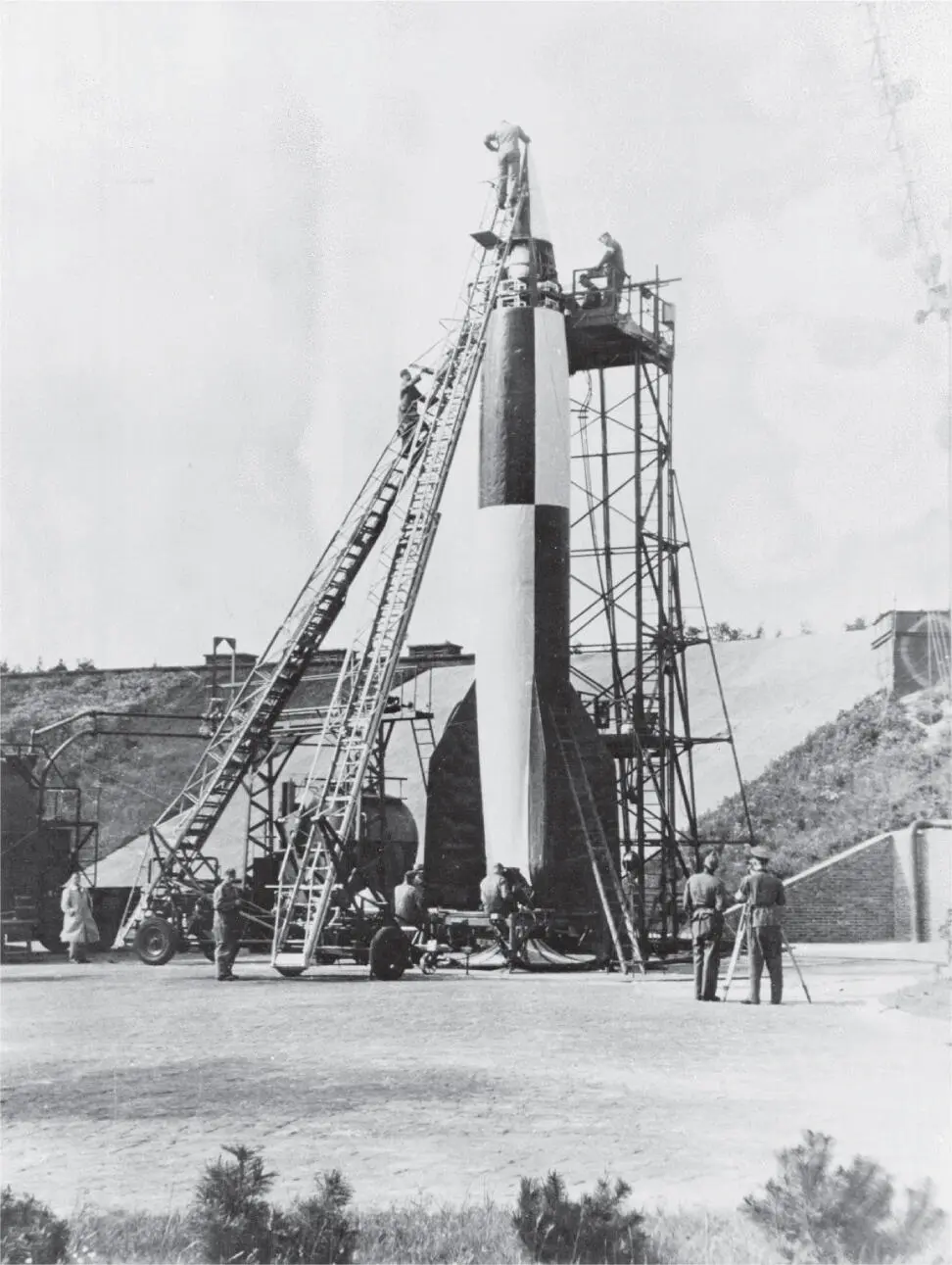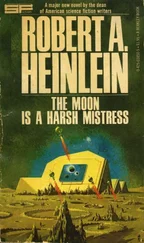1 ...7 8 9 11 12 13 ...24 
© NASA/Marshall Space Flight Center
A German V-2 rocket containing a small explosive warhead is readied for launch during the final months of World War II. More than three thousand V-2s were fired against Allied targets in England and Belgium, but as a strategic military weapon of destruction it was largely ineffective.
Ley published an article about the V-2 in an American magazine just as Allied forces entered Germany. In it he speculated that the large new rockets were the work of Hermann Oberth and thought it unlikely that either Oberth or his associates would survive to tell the story of the V-2’s birth. “Those who knew the full story are dead already,” he stated. “Those that are still alive will die before the war is over.” But far more important to Ley was its legacy: The V-2 had provided undeniable proof that it was possible to launch a large, fully operational guided missile.
Parts of a V-2 confiscated by the Allies were shipped to the United States, where Robert Goddard examined them at the Naval Experiment Station in Annapolis, Maryland. Goddard found the design of the V-2’s gyroscopically controlled stabilizing vanes, its fuel-injecting turbopumps, and its combustion chamber remarkably similar to features he had used on the rockets he developed and launched in Roswell, New Mexico. In the mid-1930s, when Goddard had been conducting his research far from the eyes of the press and curiosity seekers, both Hitler’s military intelligence organization—the Abwehr—and Soviet espionage officials had dispatched spies to gather information about Goddard’s progress. But despite Goddard’s suspicions that the V-2’s design had been stolen from his work, the technology for both rockets evolved along independent parallel tracks, with the Germans already ahead of Goddard by the early 1930s. A few days after Goddard scrutinized the confiscated V-2, Germany fell to the Allies and the war in Europe ended. Already ill with cancer, Goddard would die at age sixty-two four months later. His death came on the same week that the United States dropped two atomic bombs on Japan, ending the war in the Pacific.
In the wake of the German surrender, the United States’s joint chiefs of staff immediately approved an unprecedented new program intended to achieve a strategic military advantage over future adversaries by obtaining proprietary access to the Third Reich’s advanced weapons technology. Not only were physical weapons and plans to be seized, but the United States’s wartime intelligence agency, the Office of Strategic Services (OSS), sought to find the brainpower behind them as well.
The plan progressed so rapidly that the first group of German scientists and engineers arrived on American soil before President Truman became aware of the program’s existence. It began as Operation Overcast, an initiative focused on taking possession of Nazi scientific knowledge and technology for use in the war against Japan. However, after the Japanese surrender, the larger program was renamed Operation Paperclip and included many more former Third Reich engineers, technicians, and scientists. The code name arose from the Office of Strategic Services’ use of paperclips to mark the intelligence files of scientists and engineers selected for inclusion in the program.
Willy Ley assumed his unique knowledge of rocket science and his experience working with Hermann Oberth would help him obtain a financially secure job with either the United States government or an American corporation expanding into rocket development. But in the eyes of the American military, Ley was an outsider. He learned from contacts in the U.S. government that many of the German engineers who had designed the V-2 had survived the war and had been brought to the United States to work with the War Department. It was cruelly ironic. Ley had left Germany out of conscience, while those who had chosen to remain and build rockets for Hitler were accorded special attention and employed by the U.S. government. Many of Ley’s associates from the Verein für Raumschiffahrt who had worked on the V-2 would be among those leading the effort to make human space travel a reality. But Ley would not be among them.
From an American military officer, Ley learned that the Nazis’ director of the V-2 program had not been Hermann Oberth, as he had assumed. Its manager was Wernher von Braun, who as a bright eighteen-year-old aristocrat and part-time student had been personally introduced to Oberth and the Verein für Raumschiffahrt in 1930 by Ley. When recalling von Braun’s persuasion skills, Ley wrote his friend science-fiction author Robert Heinlein, “I only hope that the U.S. Army will not suddenly find him ‘charming’ in addition to being useful.”
In the waning days of the Third Reich, von Braun and his top associates had considered their options. Soviet forces were approaching from the east and the American Army from the west; their capture was inevitable. They knew their unique technical knowledge would give them leverage when negotiating terms of surrender. When von Braun polled his group, the consensus was to surrender to the Americans, and after hiding for a few days in a remote area of the Bavarian Alps, they made furtive contact with a U.S. infantry division. By the time the Soviet Army arrived at von Braun’s rocket development and testing area at Peenemünde on the Baltic Sea, nearly every one of the top scientists and engineers had already surrendered to the American forces.
Von Braun and more than one hundred other members of his German rocket-development team arrived quietly in the United States a few months after the end of the war in Europe. For decades, significant details about how they and other German scientists were vetted and cleared for entry were shrouded in secrecy. But it is undeniable that the United States government concealed the fact that it gave preferential treatment to some German scientists and engineers who had been Nazi Party members or suspected of complicity in war crimes.
The first public news of Operation Paperclip came in an understated press release issued by the War Department on October 1, 1945. It announced that a carefully selected number of “outstanding German scientists” would be brought to the United States to impart technical knowledge vital to the nation’s security. The one-page release said that they would be in the United States on a temporary basis and all had made the journey voluntarily. Not long after, The New York Times revealed the “entire German staff at the [Peenemünde] rocket-weapon base, about ninety men,” had arrived in the United States. In actuality, during the war as many as twelve thousand had been employed at Peenemünde, but only the top echelon—around one hundred fifty rocket scientists and engineers—had traveled to the United States to work with von Braun.
THE WAR DEPARTMENT and the Office of Strategic Services considered the German scientists and engineers such valuable assets that it was deemed far more important that the United States government gain access to their expertise and knowledge than worry about the controversial—and highly classified—details contained in their wartime files. Stalin’s encroachment into Eastern Europe had already prompted fears of a protracted conflict with the Soviet Union. And during the immediate post-war years, Americans suspected of having communist sympathies were deemed a far greater threat to the nation than someone with a past association with the defeated Third Reich.
A few years earlier, David Lasser’s tenure as the president of the Workers Alliance of America had ended when members of the Communist Party asserted domination over its leadership. Lasser was a socialist but opposed communism, and he chose to resign from the alliance in protest. President Franklin Roosevelt subsequently asked him to form an organization that would train the unemployed so that they could transition into the workforce. But his nomination ran into trouble when reactionary members of Congress discovered Lasser’s name on a list of suspected leftists. While sitting in the gallery above the United States House of Representatives, Lasser listened as a Texas congressman with a reputation for grandstanding and publicly exposing the identities of political subversives attacked his reputation. He ridiculed the author of The Conquest of Space on the House floor as “a crackpot with mental delusions that we can travel to the Moon!” The House exploded in laughter and Lasser’s nomination died in the midst of the uproar.
Читать дальше













